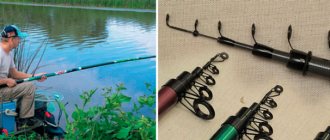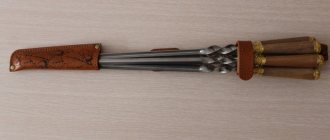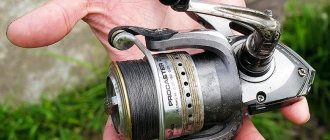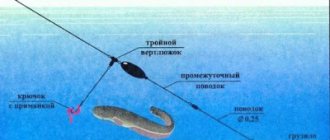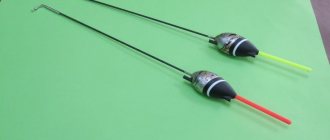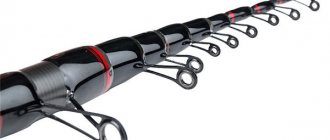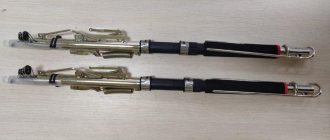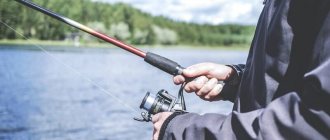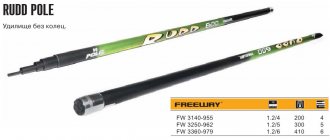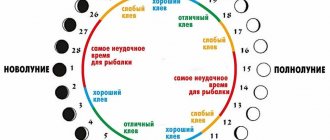Fishing with a float rod from A to Z
Fishing with a float rod is accessible to most anglers due to the simplicity of the equipment and the cost of the gear. The design of the most common fly float fishing rod consists of:
- A rod with a length of 4 to 7 meters (less than 4 meters of fishing rod will be inconvenient due to the casting distance being too short, but they are also used when fishing on ponds and places where casting can be done not very far).
- Line from 0.1 to 0.2 (0.1 is a very thin line and is more suitable for a leash, but 0.15 or 0.2 is quite suitable for the main line).
- The float should be chosen in an oblong shape, although ball- or pear-shaped ones are also chosen by anglers in cases of fishing in the current; it is also very important that the float has a fairly thin antenna for greater sensitivity (less than 3 mm is the best option).
- Lead pellets are sinkers that are attached to the fishing line by clamping with pliers (or teeth), which will load the float so that only the tip is visible from the water.
- Leash - a piece of thinner fishing line after the sinker and in front of the hook, which performs several functions at once:
- when hooking the hook, if you have to break the tackle, only the leash with the hook will break, and the remaining parts of the equipment will remain;
- a line that is less visible in the water will scare the fish less.
- The hook is tied to the leash with a special knot (the size of the hook should be comparable, first of all, to the mouth of the fish being hunted; ideally, the fish should be able to swallow the hook).
What is a float rod?
Almost every person has seen a float fishing rod at least once in their life. This is a simple device, which is a rod ranging in length from several tens of centimeters to several meters with a reel, fishing line with a float, a sinker and a hook. The material can be different - bamboo cane, plastic and other polymeric substances. Amateur fishermen sometimes make it from a small but straight branch cut down in the forest. The bait, attached to a hook, is thrown into the water using a fishing rod, and the float signals about bites.
What kind of fish can you catch with a float rod?
Depending on the fishing location, you can catch almost any fish with a float rod. The fishing depth can be easily adjusted by moving the float along the line, which significantly expands the angler’s capabilities in catching a particular fish. The main list of fish species that are most often caught using a float rod:
- Crucian carp.
- Carp.
- Rudd.
- Bream and bream, etc.
Sometimes a predator also bites on a float rod - perches often rush to a worm baited as bait. At night there is a chance of catching somenka. In general, the types of fish that can be caught with a float rod directly depend only on the bait and the place where the fish are caught.
Tackle
There are 3 main types of float gear:
- fly rod - a rig with a hook is delivered to the fishing spot with a small swing of the rod 1.5-2 rod lengths from the angler;
- a plug rod up to 20 meters long consists of several very parts that allow you to deliver equipment over a distance of the length of the rod absolutely without any swings (sports tackle);
- A match rod with a sliding rig allows you to cast over long distances and fish in great depths.
We will look at a regular fly rod, which is the simplest tackle for float fishing.
Reel and rod
A spinning reel would be superfluous, but a small drum reel would be just right
Flying rods come with or without a reel.
- A rod with a reel is easier to use and transport.
- In a fishing rod without a reel, the line is attached to the tip of the rod, and the equipment is stored on a special reel separately from the rod. This rod is lighter than a rod with a reel and you can choose a longer option.
Which one to choose? A novice fisherman can choose a rod with a reel, although the option without it is also quite suitable and convenient.
In the float rig of a fly rod, the reel serves only to store fishing line and winding/winding of fishing line occurs extremely rarely (at the beginning and at the end of fishing). A spinning reel is heavy and simply unnecessary for such fishing.
Spinning rod test
On each spinning rod, the manufacturer indicates a test - the permissible weights of the baits used. The upper and lower bait tests are indicated. When choosing a fishing rod, it is very important to understand what weights you will be working with. If you perform wiring with lures weighing 3 grams, but the minimum rod test is 7 grams, then you will not feel jerks or other movements of the bait. And if you have a rod weighing up to 15 grams, but you are trying to cast a bait weighing 25 grams, then the rod is very likely to break. Therefore, always compare the weight of your lures with the spinning rod test.
The lightest rods - ultralights - have minimal tests (1-5, 2-7, 3-8 grams). They are designed for fishing with the lightest baits and the thinnest cords. With the help of such rods you can conduct the most delicate fishing for perch, chub, pike and other predators.
Standard light models usually have a test weight from 5 to 15 grams. Such rods allow you to fish the coastal zone with light wobblers, spoons, silicone baits and other baits.
Spinning rods with a test from 7 to 25 are usually called mediums. Most of them belong to the category of universal fishing rods. With their help you can fish with a wide variety of baits.
For fishing with heavy baits, spinning rods with a weight of 20 to 35 grams are used. These are heavyweights. There are also extra heavyweights with tests up to 60 grams or more. These rods are used to catch pike perch and catfish with heavy baits. Typically, such spinning rods are used in trolling.
Equipment
For the most common equipment we will need:
- fishing line the length of the rod, or when using a reel, a longer piece (diameter 0.15-0.20);
- float with a carrying capacity of several grams;
- set with lead pellets;
- a set with rubber casings (sometimes these cambrics are included in a set with lead pellets);
- a small piece of thinner fishing line (0.1-0.13);
- hook 6-10 according to international numbering (on the link you can see the size of such hooks in full size in the image), when choosing, rely on the size of the fish’s mouth, it should fit in the fish’s mouth.
Sequence of rigging a float rod
- A small reel is attached to the rod. If the rod is without a reel, then the fishing line will be attached to the tip of the rod.
- The line wound from the reel is passed through the rings , from the one closest to the reel - to the very last ring at the tip of the rod.
- Float mount. The fishing line is passed into the ring of the float (from top to bottom), and then a small rubber cambric is put on the fishing line. The lower part of the float (keel) is inserted into the cambric.
The equipment is ready.
Fishing technique with a float rod
general information
You can fish with the above equipment at reservoir depths from half a meter to 2-3 meters (more than that, it will be problematic to make a long cast).
Most fish lead a bottom-dwelling lifestyle (crucian carp, carp, perch, bream, silver bream, ruffe), but there are also riding fish (bleak, verkhovka, rudd).
You must know what kind of fish you are hunting for , or try to fish both on the bottom and near the surface - to determine what kind of fish is found here. Setting the fishing depth is done by moving the float along the line - the closer it is to the hook, the lower the fishing depth is set. If the float is 1 meter from the hook, then the hook will be under water at a distance of 1 meter.
Finding a place and determining the depth
A novice fisherman most likely does not have an echo sounder for fishing from the shore, so he will have to determine the depth in other ways. Analysis of the water surface is very helpful in determining the nature and topography of the bottom.
In any case, your equipment will show you the most accurate depth. Approach the fishing spot - set the hook depth to 0.5 meters by moving the float and cast it to the fishing point. If the float has taken a standard position, it means it is deeper than 0.5 meters. You pull it out and increase the depth until you get the float to lie on the surface, this means that the sinkers are lying on the bottom and the depth you set is too large. Then pull out the rig and reduce the depth by 20 cm. Now your rig is set up to fish along the bottom.
Fishing for crucian carp with a float rod - an overview of gear for catching crucian carp, habits and other subtleties of catching the hardiest Russian fish.
How to choose a float fly rod.
7 simple tips on how to get fish to bite. Exclusive!
With a bombard on an asp
Sbirulino allows you to outwit a cautious asp. The weight of the projectile allows you to make a long cast and bring a small spinner, wobbler, or streamer under the nose of the striking predator. When hunting for asp, one bait is used at the end of the undergrowth. Sometimes a short leash with a streamer made of white goat hair is added above. They don’t get carried away with a large number of leashes.
Lure
To let the fish know that it is in your fishing spot that it can feast on food and your bait on the hook, you need to feed it.
You can buy bait mixtures in the store, and at the pond, mix them with soil, clay and water and begin feeding by throwing small balls into the water. Or you can prepare it yourself from cereals and many other ingredients:
- pearl barley;
- millet;
- cake;
- dill;
- bran;
- breadcrumbs;
- and other components.
Try making balls from commercial Trapper or Sensas bait. You will notice how much more effective they are than regular homemade baits.
It is also very useful for the bite to add those attachments or baits that you are going to use for bait. This increases the fish's confidence in your bait.
Try not to overfeed the fish and do not throw all the bait into the water at once. Usually, the full effect of bait begins only 15-25 minutes after feeding during the current. But in a body of water with stagnant water, the effect may be delayed. Use aromatic additives for fishing in still water.
We recommend buying bait from the following manufacturers at an affordable price:
They have been tested by many anglers.
How to choose a fishing spot
There are so-called promising places for float fishing. You should not choose areas with too winding banks, since in such places it is difficult to determine the depth of the reservoir.
The most optimal points for fishing include:
- Bays, places with standing water.
- River areas with dense vegetation.
- Pools and deep holes.
- Points with depth differences.
- Areas located around a bend in the river bed.
The video of fishing with a float rod shows that the most successful fishing spots have a slow current.
Let's sum it up
Float tackle is very common and suitable for catching both peaceful and predatory fish. Most fish willingly bite on animal baits (especially in the demi-season). But predators do not bite on plant baits.
When fishing, first of all try to catch fish along the bottom. Use “sandwiches” from various attachments.
In ponds you can most often catch with a float rod: crucian carp, perch, bleak, rotan, ruff.
On large rivers, the catch is dominated by: roach (roach), perch, bream, crucian carp, ide, silver bream, gobies and other peaceful and predatory fish.
Line for float rod
The next important point for fishing with a float rod is choosing the optimal fishing line. The most popular is single thread monofilament, and fluorocarbon fishing line is used as a leader.
Rules for selecting fishing line, depending on the type of fishing rod:
- The fly model requires a fishing line with high strength. It is especially important to choose a type of thread with tensile strength, since this fishing rod does not have a reel. The chosen thread should soften the efforts of overly active fish, for example, when fishing for carp with a float rod.
- For the Bolognese model with inertial reels, they try to choose a fishing line with no memory. Otherwise, when unwinding the thread, curls will form. Due attention is also paid to the strength of the fishing line, since during fishing the thread experiences significant stress in the form of currents and active movements of the fish.
When fishing with a float rod, a leash is always used. To make it, you should choose a particularly strong fishing line that has hydrophobic properties, a memoryless effect, and resistance to sunlight.
Choosing hooks for fishing
For effective fishing, it is important to choose the strongest possible hook. The modern market for fishing products provides a huge assortment. When purchasing tackle, you should carefully inspect the accessory for damage.
The size of the tackle is selected depending on the size of the fish. They also pay attention to the color scheme, which is chosen depending on the color of the bait or attachment used.
Lure and bait for fishing
Unlike fishing with a spinning rod, when fishing with a float rod, choosing the right bait is important. In practice, bait of animal origin (earthworms, insects, maggots) or vegetable baits, for example, various types of cereals, can be used. The specific selection of bait depends on the fishing season:
- Early spring. All species of the underwater world have an active zhor - a harbinger of spawning. The most effective fishing with a float rod in the spring is observed when using animal feed, for example, maggots, earthworms, and insect larvae.
- The spawning period, which varies among different species of fish, is not available for float fishing. In May, at the end of the spawning period, the fish again show signs of eating. During this period, various fish feedings should be used to interest river inhabitants.
- In summer, the best way to catch white fish is with a float rod. The main source of nutrition is vegetable protein, for example, boiled cereals, dough, garlic, dry aquarium food, ground sunflower seeds. After steaming, pearl barley will be an excellent food for roach, and all types of fish love semolina mash.
After the onset of cold weather and in the autumn, owners of float rods should return to bait in the form of bloodworms, insects, maggots and worms.
Autumn fishing for crucian carp is excellent with a float rod using peas as bait.
In practice, various baits are often used. Most often these are dry mixtures that must be mixed with water before use. Homemade fertilizers (corn, corn, cookies, milk powder) can be thrown into the river without diluting with water.
How to make a float rod from a spinning rod
WRAM » Sun Feb 19, 2012 9:33 pm
A fishing rod for all occasions
Driving across a bridge over the shallow but very beautiful Olym River in the Lipetsk Region, I saw a fisherman, approached him and asked how he was doing. It turned out that 250 g of chubs pecked at the worm. In the evening after work, I was already at this place.
I throw closer, further, to the right, to the left - it doesn’t bite. I felt a blow on the opposite bank, it looked like it was an asp. The water had just entered the riverbed and had not yet cleared up. I didn’t expect to meet an asp so early.
Another blow. Well, exactly, asp! I remove the float and leash with a hook, and install a 12-gram castmaster from ACME. I throw it into the battlefield under the other bank. Somewhere on the sixth wire a powerful grip follows. After a fair amount of resistance, the 2 kg asp ends up on the shore. The end of the evening is another foal weighing 0.5 kg.
Once again, my universal fishing rod did not disappoint.
Often fishermen come up to me on a pond and ask: “You were just sitting here with a float, and now you’ve already pulled out a pike on a spinning rod.” How did you manage that?
But if a pike strikes nearby, why not throw bait to it?
When traveling to the country or on other errands, when the car trunk is filled with all kinds of luggage, every fishing enthusiast is faced with the problem of placing fishing rods in the car. I chose an inexpensive but very worthy telescopic spinning rod SHIMANO Catana with a length of 270 cm (you can take 300 cm) with a test of 10-30 g. In the assembled position, it is only 68 cm long, so it easily fits on a shelf behind the rear seats of a car or in trunk, always ready to go. It only takes a few seconds for the spinning rod to become a match rod or just a donkey. There is no need to bandage anything!
What does my gear consist of for such spontaneous fishing trips?
I equip my spinning rod with an inexpensive SHIMANO Exage 4000 RA spinning reel, and I wind a monofilament line on the spool (I prefer MITSHUBISHI Asso Diamond with a diameter of 0.28 mm, yellow). Having threaded the fishing line through all the guide rings, I put two soft cambric “beads” on it (I cut off pieces from the internal insulation of an old television cable) so that the fishing line is not damaged, and tie a carabiner with a swivel. Then above the “beads” I tie a locking knot made of “braid” or a thin nylon cord (it flies through the rings better than rubber), below the “beads” I tie a knot made of fishing line (knitted from braid, it does not hold the float on the fishing line well from sliding onto the carabiner during power casting).
I equip floats weighing from 1.5 to 6 g with carabiners and store them in a used aerosol can.
When making leashes, I leave about 5 cm of fishing line at the loop, at the end of which I tie a simple knot, and on the same tail (so as not to further injure the thin leash) above the knot I pinch several weights made from strips of soft lead. If necessary, they are easier to remove than “pellets”.
Each float has its own leash with the required weight of sinkers. Now it’s enough to install a float between the beads, and put a corresponding leash with weights on the end carabiner - and we have a float rod for long casting in our hands.
By removing the float and placing a heavy sinker or feeder (photo 1-2), we get bottom tackle.
We remove the leash and sinker, hook the bait to the carabiner - and now we have a spinning rod in our hands. All manipulations will take a few seconds. There is no need to remove the “beads”, they do not interfere with spinning, if desired, additional bait can be fixed between them (photo 4), and in the bottom version they are shock absorbers and protect the carabiner assembly from the impact of the sinker. The SIC guides, which are equipped with the Catana telescopic spinning rod, allow the use of braided line, so on the second spool of this reel I wind Power Pro or FireLine braid with a breaking load of up to 20 kg (in most cases this is enough) for catching pike or carp in a snag.
Materials for making a fishing rod
The simplest spinning rods are made of fiberglass. They are heavy and reliable. Such models are suitable for trolling fishing, when you do not need to pick up the rod often. The significant weight of fiberglass rods does not allow fishing with them for a long time. Your hand will get tired quickly. And the blank of these rods cannot be called sensitive. Therefore, fishing with light baits is ineffective.
More advanced and expensive spinning rods are made from composites. Composites are obtained by mixing carbon fiber and glass fiber. The result is a material with the properties of carbon fiber and fiberglass.
Composite spinning rods can be recommended to those fishermen who cannot afford to purchase a more expensive carbon fiber rod. However, now more and more affordable carbon fiber models are appearing in stores. In price, many of them are comparable to composite spinning rods. Therefore, it is better to try to choose from more budget-friendly, but carbon-fiber spinning rods.
Carbon fiber, graphite, and carbon spinning rods are made from the same material. Three different names for materials mean the same thing. These rods are the lightest in weight and have good flexibility.
Carbon fiber rods differ in their modulus of rigidity and are designated M1, M2, M3. The lower the number, the more flexible the rod. Such spinning rods have greater sensitivity, but do not throw the bait so far.
Stiffer models contain more carbon fibers. With their help you can make long casts. The optimal choice for beginners can be considered spinning rods with a stiffness module of M4, M5 and M6.
How to make a spinning rod from a fishing rod
How to make a spinning rod with your own hands - before we start analyzing the creation of a spinning rod, you should first find out under what circumstances the fishing will take place. When planning fishing with a homemade spinning rod from a boat, there is no need to prepare parts for an extended fishing rod. And, on the contrary, fishing from the banks with a small rod is not very convenient. The most suitable length of a spinning rod, providing sufficient swing from the shore and comfortable fishing, is two and a half meters. You also need to take into account fundamental things - the test and structure of the fishing rod.
How to assemble a spinning rod - necessary materials
To assemble the best spinning rod options, take:
- Rod for fishing tackle.
- Multiplier reel type.
- Laces.
- Prepared leashes with carabiners.
- A set of various baits (not live). If you plan to hunt live bait with a spinning rod, suitable hooks will come in handy.
The most difficult thing is assembling the fishing rod. Its design features and characteristics will determine what it will be: a fishing rod for twitching or trolling fishing. When partially assembling a fishing rod with a float, all the features regarding the location of the reel, the distance from the beginning to the end of the handle, the float system, and so on are taken into account.
Forms and reels with certain parameters are purchased at retail outlets. Choose handles from materials you have at home. An example of such materials is a door handle that was not used. Basically, make sure that the smooth part of the handle prevents your hand from slipping. The hotel part is closed with a cork.
Place the spool holder in a convenient place. Professional fishermen advise using moving options. They do the following - they allow you to change the state of the reel handle.
Many people will ask how to properly secure the rings? Secure the passage ring along the seams of the knee of the form. The ring is secured using its insulating property, and the legs are wrapped with nylon thread dipped in epoxy resin liquid. Insert the form into the sharpened handle and fix it using the same liquids and resins.
The final assembly of the fishing rod is carried out after the glue has completely dried. If you wish, you can assemble a rod from a fishing rod in a short time.
The first method of making a spinning rod
When creating a fishing rod, you need to know that the ability to influence the tips of a spinning fishing rod is especially inferior to a feeder type. Among other things, when using a feeder, the fishing rod used must include a test that will ensure casting of a filled feeder.
There is no need to convert the fishing rod into a donkey; the main thing you need is to choose a method that creates conditions for not cutting off such elements:
- cord;
- fishing line
When a metal leash was used on a fishing rod for the purpose of catching pikes and other fish, it would be quite sufficient to fasten a fishing line with a form of food on a swivel and a “rope” of fishing line up to fifty centimeters long in place of the bait to the carabiners. There is an additional method for creating a fishing rod for spinning fishing (bottom area).
A very successful method for creating a spinning rod deserves more attention.
The bait needs to be unfastened from the main line along with the knot and done this:
- On the main fishing line, attach a bead up to thirty centimeters in length;
- On the line, use a carabiner to put on a prepared leash with a hook. In this case, the bead will play the role of support;
- then, at the end point of the main scaffolding, a regular loop is created, to which a sinker or feeder is attached;
- the loop must be secured with a camprig or a special stopper.
During the entire fishing process, bite signals are the top of the unit. If there is no bite, then you can tighten the tackle a little (twenty to thirty centimeters). There is no bite for a long time - recharge the feeder.
Assembling your own spinning rod is profitable
You can catch large fish with a spinning rod and actively participate in the process of catching it. This will require physical force. Often fishermen have to walk 5-6 kilometers a day and constantly cast gear.
At first you will think that this activity is boring, but once you get the hang of it and find the perfect spinning rod, you won’t be able to stop.
Beginners in this business do not want to splurge on expensive products. Therefore, you can always find instructions for creating:
- Reel seat for any spinning rod;
- Leashes made from scrap materials;
- Reel holder for tackle.
Spinning rod made of wood
Materials and tools needed to create:
- Thick wooden stick. A ski pole with a length of 80 cm is suitable;
- Whips. Made from fiberglass or carbon fiber. The length should reach 1 meter. You can buy it in sports stores;
- A sleeve whose diameter matches the diameter of the stick;
- Solid foam;
- Glue “Moment” or “Super cement”;
- File or sandpaper;
- 2 metal rings, the thickness of which should be 2-3 mm, and the diameter - 1-1.5 cm;
- 3−4 access rings;
- A tulip, which you can buy in fishing stores or make yourself from the cage of a small ball bearing;
- Nitrolac;
- Thread bandage. Can be purchased at fishing stores.
Now you can start assembling the future spinning rod:
- First, prepare your ski pole: sand it thoroughly with a file or sandpaper; After this, connect its upper part with a pre-prepared sleeve. This is the basis of the future fishing rod, which needs a strong handle;
- You can choose the material for the handle yourself. However, the best option is to use rigid foam. When fishing, the tackle will not slip out of your hands. You need to make small cylinders from polystyrene foam, the thickness of which will be about 2-3 cm, and the diameter - 2.5-3 cm;
- Use a drill to make holes in them. The thickness of the cylinders should be such that the base of our shaft fits tightly and is secured;
- Then, using “Moment” or “Super Cement” glue, you need to lubricate our prepared rod base and insert it into the handle parts;
- As soon as the product dries, the handle needs to be sanded well, bringing its thickness to the one that will be ideal for your hand;
- Next, take the metal rings. If you couldn’t find them in a store, you can make them from an old vacuum cleaner tube by cutting pieces of a certain thickness. The result is a convenient reel seat attached to the spinning rod;
- The rings need to be secured to the handle of the future fishing rod using superglue, and the reel should be inserted onto them;
- Next, take the tulip and use glue to place it on the tip of the ski pole;
- Attach 3-4 guide rings to the rod. The distance between them should be the same;
- Additionally, secure the metal rings with a thread bandage, and then treat them with nitro varnish.
Bamboo spinning rod
According to many experienced fishermen, a bamboo rod is perfect for sport fishing. It is recognized as one of the best materials for creating fishing rods.
Professionals recommend creating it from several knees at once, since bamboo is not a cone-shaped plant. It is also impossible to make tackle from natural bamboo without pre-treatment. When fishing, severe deformation of the shaft or bending of the knots may occur.
Heat treatment will help: place the bamboo in boiling water for several hours to increase the strength of the material.
To make a spinning rod with your own hands, you need to prepare:
- Connecting tube made of high quality metal. Brass or aluminum are best. These materials have high strength and are not subject to premature corrosion. The diameter of the tube should be slightly smaller than that of bamboo;
- Gas or kerosene burner;
- Glue "Moment";
- 2 metal and 3 pass rings;
- Solid foam or several cork rings;
- Tulip.
Once all the products have been prepared, you must:
- Insert the tube into the bamboo;
- Then you need to heat the workpiece to ensure a firm fit of the tube in the bamboo. To do this, you can use a gas burner. The product must be heated at a distance of 15 cm to prevent the bamboo from overheating or charring;
- Also, the top of the future rod needs to be crimped using a smooth metal object;
- As soon as the products are firmly attached to each other, the metal tube must be lubricated with superglue and inserted into the hole of the bamboo;
- Additionally, warm up the elbow joints. Spend 4 minutes warming each one up;
- Next, the future fishing rod must be cooled at room temperature for 4 hours;
- After this, prepare a handle from hard foam or thick cork rings: drill holes in them, the rod will be inserted into them;
- Then use superglue to connect the two parts;
- Fill the rod with wood shavings through the top so that moisture does not accumulate inside and the tackle does not lose its elasticity;
- After this procedure, lubricate the workpiece with nitro varnish and let it harden;
- Attach guide rings and a tulip to the rod, and metal rings with a reel to the handle.
How to assemble a spinning rod for different fishing conditions
When assembling gear yourself, you need to take into account a huge number of conditions. The finished product must be suitable for fishing conditions. The main criteria are:
- Size and weight of fish caught;
- Types of baits that are planned to be used, as well as methods of wiring them;
- Planned fishing distance;
- Place of fishing, its conditions, type of reservoir.
When creating gear, you need to take into account its length and weight. These parameters must be balanced for the fishing technique to be effective.
Once you have created the perfect rod, you need to test it in different conditions.
Prepare your bait in advance. Their weight should be:
± 10 g; ± 15 g; ± 25 g; ± 50 g (for this you can use a microjig spinning rod); ± 250 g (if heavy-duty sticks were used to create the fishing rod).
Main parts of the spinning rod
Once you have assembled the spinning rod yourself, you need to take care of its main parts - the reel and fishing line.
Coil
In many fishing stores you can find the following varieties:
- Inertial. Not popular: using them to cast correctly is difficult;
- Inertialess. They are popular among novice anglers and hobbyists;
- Animators. Professional reels that are used for catching large fish, as well as for casting over long distances.
How to choose a spinning rod
The water, the fish and the fishing method, not to mention the angler's personal preferences, determine his equipment.
Spinning rod for catching small fish
To catch small fish, you need a short, lightweight rod with a length of 150 - 180 centimeters, a small reel with a spool capacity of 100 - 125 meters of fishing line, with a diameter of 0.10 - 0.23 millimeters, tested for strength. Choose a rod designed to cast bait weighing from 2 to 10 grams. This equipment is best suited for fishing for small trout, American bass and pike, and for fishing from a boat in small ponds, rivers and streams.
Spinning rod for catching medium fish
Lightweight spinning equipment consists of an elastic rod 210 - 250 centimeters long, designed to cast bait weighing 10 - 20 grams, a small reel and fishing line with a diameter of 0.23 - 0.30 millimeters. A lightweight rod with an extended handle for two-handed casting gives you greater control and expands your capabilities.
Spinning rod for catching large fish
A classic multi-purpose set consists of a rod 230 - 320 cm long, designed to cast bait weighing 12 - 28 grams, a medium-sized reel and 150 - 180 meters of fishing line with a diameter of 0.25 - 0.35 millimeters. This equipment is strong enough for casting medium-weight lures such as wobblers, oscillating and rotating spoons. With its help you can even compete with such serious opponents as pike, salmon and lake trout.
